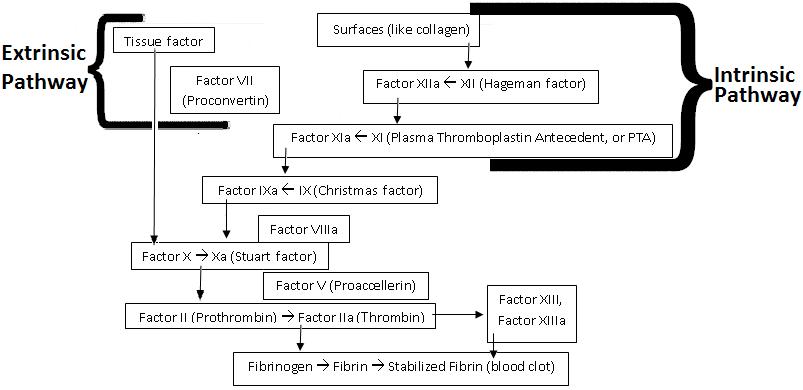 Evolution
Evolution
 Intelligent Design
Intelligent Design
 Life Sciences
Life Sciences
How Kenneth Miller Used Smoke-and-Mirrors to Misrepresent Michael Behe on the Irreducible Complexity of the Blood-Clotting Cascade (Part 1)
During the Kitzmiller v. Dover trial three years ago, biologist Kenneth Miller claimed that biochemist Michael Behe’s arguments in Darwin’s Black Box regarding the irreducible complexity of the blood-clotting cascade were false. Miller’s testimony led federal district court judge John Jones to assert in his decision that “scientists in peer-reviewed publications have refuted Professor Behe’s predication about the alleged irreducible complexity of the blood-clotting cascade.”
But an analysis of Miller’s arguments demonstrates that he refuted Behe in no way whatsoever, and that in fact it was Behe who refuted Miller at trial, although Judge Jones ignored Behe’s testimony. Miller continues (I am told) to go around lecturing on this topic, claiming that the blood-clotting cascade of lower vertebrates demonstrate that Behe was wrong and that the blood-clotting cascade is amenable to explanation by Darwinian evolution. Like many Darwinist claims of refutation of Behe, this one is based on smoke and mirrors.
First, A Mirror
During his Kitzmiller testimony, Miller’s first misrepresentation was to equate Michael Behe’s arguments in Darwin’s Black Box regarding the blood-clotting cascade with those in the textbook Of Pandas and People (Pandas). Miller stated, “[W]hen I read through the pages of Darwin’s Black Box, I was struck by how many of the arguments used against evolution that are found in Of Pandas and People are also used in Darwin’s Black Box. And the one that really stuck in my mind was the discussion of the blood-clotting cascade in both Dr. Behe’s book and in Of Pandas and People. It struck me as essentially–the two discussions struck me as essentially identical.” (Miller, September 26 AM testimony, pg. 108, emphasis added.) So according to Miller, the treatment of the blood-clotting cascade in Pandas is “essentially identical” to the treatment of the blood-clotting cascade in Darwin’s Black Box.
The problem is that Miller’s claim is false. Behe’s treatment of the blood-clotting cascade in Darwin’s Black Box is much more precise than the treatment in Pandas, and in fact Behe made it very clear that he was limiting his argument for irreducible complexity to a particular segment of the blood-clotting cascade that had been well-studied and was well-understood.
Then A Puff of Smoke
By equating Behe’s treatment of blood clotting with that of Pandas (see above), and by quoting Pandas’ statement that “Only when all the components of the [blood clotting] system are present and in good working order does the system function properly,” Miller implied to Judge Jones that according to Darwin’s Black Box the entire blood-clotting cascade is irreducibly complex. Wrong. While Pandas made the claim of irreducible complexity with respect to the entire blood-clotting cascade, Behe in Darwin’s Black Box did not.
To understand the difference between Behe’s views and the account in Pandas, one needs to understand some basics about blood-clotting cascades.
Roughly speaking, in land-dwelling vertebrates, there are two different pathways by which the blood-clotting cascade can be initiated — the “intrinsic” pathway, and the “extrinsic” pathway. (There can be some crossover between the two pathways.) The final stages of the blood-clotting cascade take place after either pathway reaches factor X, also called the Stuart factor. These final stages of the cascade are what Behe calls “beyond the fork” or “after the fork.” Figure 1 below contains a very rough description of how the blood-clotting cascade can be initiated by either the extrinsic or intrinsic pathway before it forms a final clot, and Figure 2 contains a full description of the land-dwelling vertebrate blood-clotting cascade.
Figure 1: Rough sketch of the intrinsic and extrinsic pathways of the blood-clotting cascade:
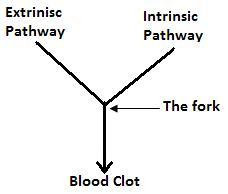
Figure 2: The blood-clotting cascade of land-dwelling vertebrates with both intrinsic and extrinsic pathways labeled (click on graphic to see the full diagram):
(Information sources for figure: Of Pandas and People, Darwin’s Black Box, Wikipedia, Barbara Forrest, Paul Gross, “Biochemistry by design,” Trends in Biochemical Sciences, Vol. 32(7):301-310 (2007).)
In Darwin’s Black Box, Behe specifically stated that his argument for irreducible complexity only pertained to irreducible complexity “beyond the fork” where the intrinsic and extrinsic blood-clotting cascades converge. As Behe writes:
Leaving aside the system before the fork in the pathway, where some details are less well known, the blood-clotting system fits the definition of irreducible complexity. … The components of the system (beyond the fork in the pathway) are fibrinogen, prothrombin, Stuart factor, and proaccelerin. … in the absence of any one of the components, blood does not clot, and the system fails.
(Michael Behe, Darwin’s Black Box: The Biochemical Challenge to Evolution, pg. 86 (Free Press, 1996), emphasis added.)
Behe even explained this very point to Judge Jones, making it clear that his own argument was not as expansive as that of Pandas:
The relative importance of the two pathways in living organisms is still rather murky. Many experiments on blood clotting are hard to do. And I go on to explain why they must be murky. And then I continue on the next slide. Because of that uncertainty, I said, let’s, leaving aside the system before the fork in the pathway, where some details are less well-known, the blood clotting system fits the definition of irreducible complexity. And I noted that the components of the system beyond the fork in the pathway are fibrinogen, prothrombin, Stuart factor, and proaccelerin. So I was focusing on a particular part of the pathway, as I tried to make clear in Darwin’s Black Box. If we could go to the next slide. Those components that I was focusing on are down here at the lower parts of the pathway. And I also circled here, for illustration, the extrinsic pathway. It turns out that the pathway can be activated by either one of two directions. And so I concentrated on the parts that were close to the common point after the fork. So if you could, I think, advance one slide. If you concentrate on those components, a number of those components are ones which have been experimentally knocked out such as fibrinogen, prothrombin, and tissue factor. And if we go to the next slide, I have red arrows pointing to those components. And you see that they all fall in the area of the blood clotting cascade that I was specifically restricting my arguments to. And if you knock out those components, in fact, the blood clotting cascade is broken. So my discussion of irreducible complexity was, I tried to be precise, and my argument, my argument is experimentally supported.
(Michael Behe, Oct. 18 testimony, pg. 25-28, emphasis added)
The components that Behe claimed were irreducibly complex are contained in the red box seen in the diagram of the land-dwelling vertebrate blood-clotting cascade below:
Figure 3: Components that Michael Behe argued comprised the irreducibly complex core of the blood-clotting cascade:
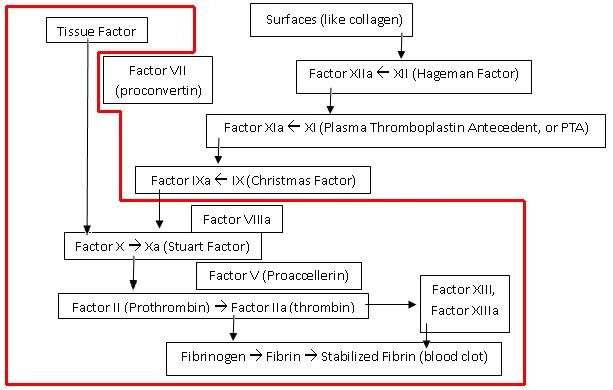
(Information sources for figure: Of Pandas and People, Darwin’s Black Box, Wikipedia, Barbara Forrest, Paul Gross, “Biochemistry by design,” Trends in Biochemical Sciences, Vol. 32(7):301-310 (2007).)
Behe provided Judge Jones with an experimentally verified case for irreducible complexity of the blood-clotting cascade with respect to particular proteins within the cascade: fibrinogen, prothrombin, and tissue factor. He discussed the cascade “after the fork” where the intrinsic and extrinsic pathways converge. Behe didn’t want to extend his argument too far, because adequate experimental tests had not yet been performed to demonstrate irreducible complexity with respect to some of the other factors, particularly those involved in the intrinsic pathway.
And Then Another Mirror
In his effort to refute Behe, Miller also discussed the fact that blood-clotting cascades in whales and dolphins lack factor XII (also called the Hageman factor), and the blood-clotting cascade in puffer fish lacks factors XI, XII, and XIIa. As Miller testified: “Whales and dolphins, in 1969, well before Pandas was published, were shown to lack factor 12. … The proposal is that we take away the three parts which are known as the contact phase system. Now, that includes factor 12, which we talked about a second ago, but also factor 11 and also the factor that catalyzes the conversion of 12 to the active form. It turns out these three parts are missing in a vertebrate known as the puffer fish.” (Miller, September 26 AM testimony, pgs. 126-128).
Miller concluded that since these cascades “are missing three parts of the system and their blood clots perfectly well,” that therefore the irreducible complexity of the entire land-dwelling vertebrate blood-clotting cascade is “refuted by the scientific evidence.” (pg. 129) The implication was that Behe’s argument for irreducible complexity of the blood-clotting cascade had been refuted as well as the more expansive argument in Pandas. But Miller did not refute Behe’s argument, because Miller only gave evidence that some vertebrates (like dolphins or jawed fish) lack certain components involved in the intrinsic pathway (factors XI, XII, and XIIA) found in land-dwelling vertebrates. What Miller failed to acknowledge is that land-dwelling vertebrates, jawed-fish, and water-dwelling mammals like dolphins and whales still have the extrinsic pathway intact, as well as everything after the point where the intrinsic and extrinsic pathways combine in land-dwelling vertebrates. In other words, dolphins and jawed fish still have the factors in the blood-clotting cascade that Behe considers irreducibly complex (i.e. those “after the fork”). They even have the factors on the blood-clotting cascade’s extrinsic pathway. The only factors they appear to be missing are the portions on the intrinsic pathway. Since Behe’s argument did not include any of those factors on the intrinsic pathway, and only dealt with factors shared by jawed fish (like the puffer fish), water-dwelling mammals, and land-dwelling vertebrates, Miller’s argument did not refute Behe’s argument at all.
But there is more.
The Blood-Clotting Cascade’s Irreducible Core
The blood-clotting cascade pathway of jawed fish has an important difference from that of land-dwelling vertebrates because fish don’t have an intrinsic pathway found in land-dwelling vertebrates. That doesn’t mean that the rest of the cascade isn’t irreducibly complex, for both may have a core system of parts that is irreducibly complex. And how do we know there’s an irreducible core comprised of parts Miller didn’t address in his testimony? Because experimental evidence, cited by Michael Behe during the Kitzmiller trial and in Darwin’s Black Box, shows that some components of this system are absolutely necessary to have a functional blood-clotting system.
The “irreducible core” is a long-standing concept within ID thinking that William Dembski and Jonathan Wells define as follows:
A functional system is irreducibly complex if it contains a multipart subsystem (i.e. a set of two or more interrelated parts) that cannot be simplified without destroying the system’s basic function. We call this multipart subsystem the system’s irreducible core. … We therefore define the core of a functionally integrated system as those parts that are indispensible to the system’s basic function: remove parts of the core, and you can’t recover the system’s basic function from the other remaining parts.
(Jonathan Wells and William Dembski, The Design of Life: Discovering Signs of Intelligence in Biological Systems, pp. 146-147 (Foundation for Thought and Ethics, 2008).)
Dembski also discussed the concept of the “irreducible core” in his 2001 book No Free Lunch where he wrote, “Consider an old-fashioned pocket-watch with a winding mechanism. The basic function of the watch is to tell time. What’s more, many parts of the watch are indispensable to that basic function, for instances, the spring, the face, the hand, and the minute hand. On the other hand, other parts of the watch are dispensable, for instance the crystal, the metal cover holding the crystal, and the chain. By focusing purely on the indispensable parts of the pocket watch one obtains what can be called an irreducible core that has all the crucial properties of irreducibly complex systems considered so far. It therefore makes sense to define an irreducibly complex system as one that contains an irreducible core whose parts are each indispensable, but where the system is itself permitted to certain unnecessary or redundant elements.” (No Free Lunch, pg. 285)
I like to explain the “irreducible core” using the analogy of a bicycle: A bicycle has an irreducible core that requires a frame, two wheels, a motor mechanism (like legs on pedals), and a steering mechanism (like handle-bars attached to the front wheel). A bicycle also has a seat, but obviously you can ride a bike without a seat (though it wouldn’t be very fun). So, while the seat sure helps a lot, it is not part of the irreducible core of a bike. Same could be said for light deflectors, etc. So the fact that a bike has a couple dispensable parts doesn’t mean that there isn’t an irreducible core to a bike.
In this regard, under Miller’s style of argument, at the very least, the blood-clotting cascade of jawed fish and land-dwelling vertebrates might all share the parts seen in the diagram below, meaning that their blood-clotting cascade might have an irreducible core which looks like this (the diagram below basically shows the blood-clotting cascade of jawed-fish):
Figure 4: The blood-clotting cascade of jawed fish, which also represents the components of the blood-clotting cascade of land-dwelling vertebrates that Michael Behe argued formed an irreducibly complex core:
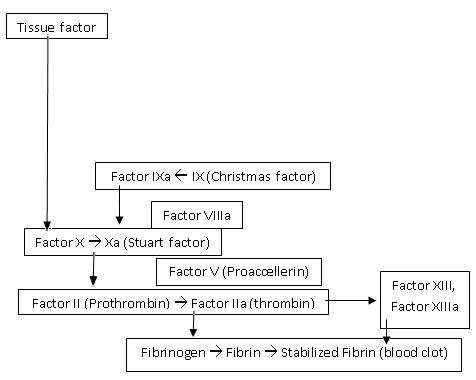
(Information Sources for Figure: Of Pandas and People, Darwin’s Black Box, Wikipedia, Barbara Forrest, Paul Gross, “Biochemistry by design,” Trends in Biochemical Sciences, Vol. 32(7):301-310 (2007).)
By finding that both jawed vertebrates and land-dwelling vertebrates contain all of the above components — the extrinsic pathway and everything “after the fork” — Miller’s arguments, at most, show that there is an irreducible core comprised of the components in the above diagram. Perhaps the intrinsic pathway of land-dwelling vertebrates (missing from this diagram) is not part of this irreducible core. If that’s the case, this does not refute irreducible complexity for the rest of the system; it just shows that those components in the intrinsic pathway aren’t indispensable to the system. The fact that land-dwelling vertebrates have an intrinsic pathway does NOT negate the existence of an irreducible core. Incidentally, this diagram contains all of the components which Behe said are part of the irreducible core. So Miller in no way refuted Behe.
Figure 5: This diagram shows the blood-clotting cascade of land-dwelling vertebrates. The red box shows the components that Michael Behe argues form the irreducibly complex core of the blood-clotting cascade. The green box shows the components which Ken Miller claims are dispensable to the blood-clotting cascade. Since the boxes don’t overlap, it can be seen that Miller didn’t even address Behe’s arguments. In other words, none of Miller’s comparative biochemistry examples of blood-clotting cascades in various species lacked any of the factors that Behe claimed were part of the irreducibly complex core. Nonetheless, Judge Jones had the temerity to rule that “scientists in peer-reviewed publications have refuted Professor Behe’s predication about the alleged irreducible complexity of the blood-clotting cascade.”
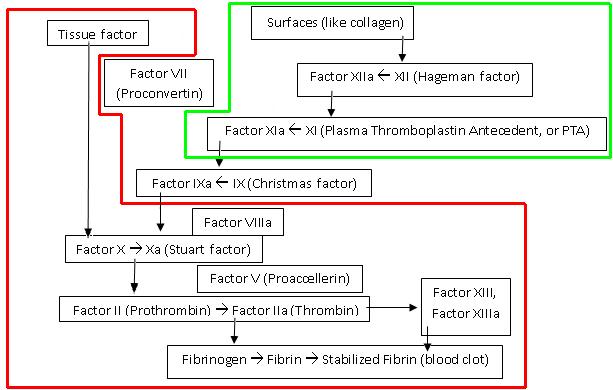
(Information sources for figure: Of Pandas and People, Darwin’s Black Box, Wikipedia, Barbara Forrest, Paul Gross, “Biochemistry by design,” Trends in Biochemical Sciences, Vol. 32(7):301-310 (2007).)

